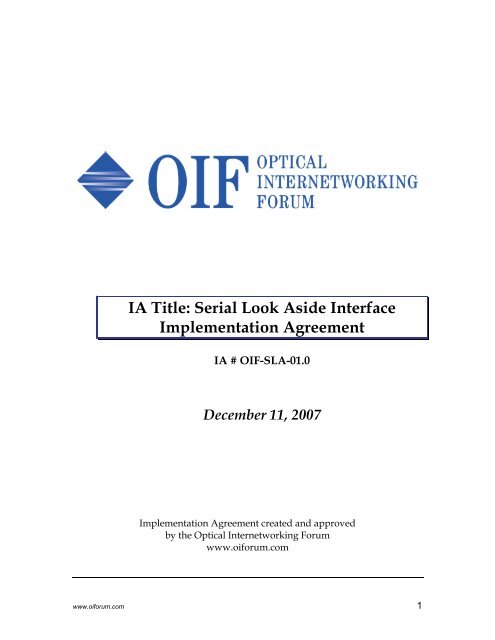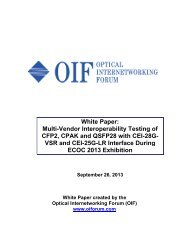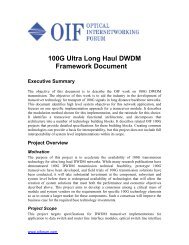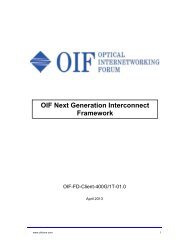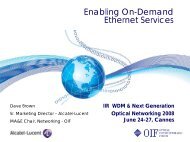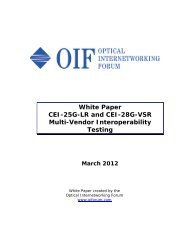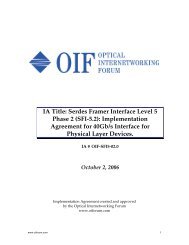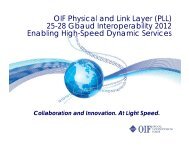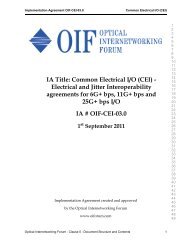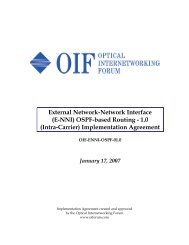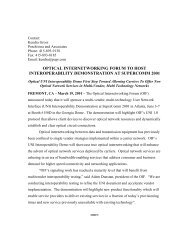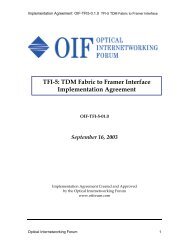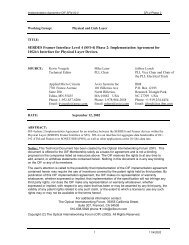IA Title: Serial Look Aside Interface Implementation Agreement - OIF
IA Title: Serial Look Aside Interface Implementation Agreement - OIF
IA Title: Serial Look Aside Interface Implementation Agreement - OIF
You also want an ePaper? Increase the reach of your titles
YUMPU automatically turns print PDFs into web optimized ePapers that Google loves.
<strong>OIF</strong>‐SLA‐01.0<strong>Serial</strong> <strong>Look</strong> <strong>Aside</strong> <strong>Interface</strong>2 List of FiguresFIGURE 5-1 SYSTEM LEVEL ARCHITECTURE EXAMPLE........................................................ 9FIGURE 5-2 RING AND CASCADE ARCHITECTURES ............................................................ 10FIGURE 6-1 REFERENCE MODEL ........................................................................................ 12FIGURE 6-2 SLA BI-DIRECTIONAL ..................................................................................... 13FIGURE 6-3 SLA UNI-DIRECTIONAL................................................................................... 14FIGURE 6-4 SLA ASYMMETRICAL ..................................................................................... 14FIGURE 7-1 CONTROL BLOCK FORMAT.............................................................................. 16FIGURE 7-2 COMMON REFERENCE CLOCK ......................................................................... 183 List of TablesTABLE 1 STATUS DATA ADDRESS DECODING.................................................................... 17www.oiforum.com 5
<strong>OIF</strong>‐SLA‐01.0<strong>Serial</strong> <strong>Look</strong> <strong>Aside</strong> <strong>Interface</strong>4 Document Revision HistoryRevision Date Revision3 16/08/2007 Straw Ballot candidate4 10/17/2007 Incorporate Straw Ballot commentswww.oiforum.com 6
<strong>OIF</strong>‐SLA‐01.0<strong>Serial</strong> <strong>Look</strong> <strong>Aside</strong> <strong>Interface</strong>by SPI-S than through SLA. The rationale is to simplify the co-processorimplementation wherever possible.5.4 Typical Applications5.4.1 System Architecture ExamplesFigure 5-1 is a reference diagram illustrating a typical application utilizing theSLA.Memory/Co-Processor<strong>Serial</strong> <strong>Look</strong>-<strong>Aside</strong><strong>Interface</strong>(Transactional)Framer/Co-Processor/FabricASIC /ASSP /NPUFabric/Co-Processor/FramerStreaming<strong>Interface</strong>(Packet / Cell )Figure 5-1 System Level Architecture Example5.4.2 SLA ConfigurationsSLA supports both cascade and ring architectures (see Figure 5-2). Because theSLA specifies only the interface between the host and the first adjacent coprocessordevice, interconnect strategies for slave-to-slave connections in eitherthe cascade or ring topologies is application dependent. Alternative topologiesare possible and not prohibited by SLA.www.oiforum.com 9
<strong>OIF</strong>‐SLA‐01.0<strong>Serial</strong> <strong>Look</strong> <strong>Aside</strong> <strong>Interface</strong>SHOULD indicates that the item is not required by this specification, but isoffered as implementation guidance.In addition:If there is a conflict between the SPI-S specification and the text of this documentthen the SPI-S specification takes precedence over this document.Figures (except state diagrams) are informative only.Footnotes used in this specification are informative only.A reserved field or bit shall be transmitted as zero and shall be ignored onreception.5.7 DefinitionsThis specification makes use of defined terms in the SPI-S document. However,the terms below are either modified from the SPI-S document or are new:Network Processing Element (NPE):Any device that uses the SLA as a look-side interface to a co-processor.This differs from the SPI-S definition that groups co-processors into theNPE class and uses SPI-S for communication.Payload Data:Response:Data on the SLA link that is part of a transaction Request or Response.Any solicited data or indication returned by the Slave (co-processor) as aresult of transaction Request made by the Host (NPE).Request:A command issued to the Slave (co-processor) by the Host (NPE).6 Architectural OverviewThe SLA provides for the transfer of data traffic and flow control informationbetween NPE and co-processor device. The framing format supported for thedata framing is described in the following section.www.oiforum.com 11
6.1 SLA Reference Model<strong>OIF</strong>‐SLA‐01.0<strong>Serial</strong> <strong>Look</strong> <strong>Aside</strong> <strong>Interface</strong>The SLA supports one framing format defined below and illustrated in Figure6-1:o 64B/66B: 10 Gigabit Ethernet compatible framing and scrambling. Amandatory mode of operation utilizing 64B/66B coding and scrambling,as defined in IEEE802.3ae-2002 [2]:o Clause 49.1.4.1 - PCS introductiono Clause 49.2 - Physical Coding Sub layerData <strong>Interface</strong>Flow Control <strong>Interface</strong>SLA Data <strong>Interface</strong>(Forward Channel)SLA Flow Control <strong>Interface</strong>(Reverse Channel)64/66BCommon Electrical <strong>Interface</strong><strong>OIF</strong>-CEI:6G or 11GFigure 6-1 Reference Model6.1.1 Features of SLAThe SLA has the following characteristics:• It can efficiently transfer a range of transaction sizes, such as:o Memory reads or writes• Address resolution requests/responses (i.e. MAC/IP lookup)• Access Control List/QoS Classification requests/responses (N-tuple)The logical operation is based on the SPI-S specification.www.oiforum.com 12
<strong>OIF</strong>‐SLA‐01.0<strong>Serial</strong> <strong>Look</strong> <strong>Aside</strong> <strong>Interface</strong>NPE<strong>Serial</strong><strong>Look</strong>aside<strong>Interface</strong>TransmitLink LayerDeviceRequestStatusEgress: 1-N PHY LinksTx Request with Optional MessagingCo-ProcessorSingle Simplex Logical Link1-N Simplex PHY LinksFigure 6-3 SLA Uni-directionalNPE<strong>Serial</strong><strong>Look</strong>aside<strong>Interface</strong>TransmitLink LayerDeviceRequestStatusEgress: 1-N PHY LinksIngress:1 PHY LinkTx RequestTX Flow ControlCo-ProcessorUnidirectional Requestswith reverse status channel2-N PHY LinksFigure 6-4 SLA Asymmetrical7 Data Path OperationsThe data path operation of SLA is identical to SPI-S with the followingexceptions:www.oiforum.com 14
<strong>OIF</strong>‐SLA‐01.0<strong>Serial</strong> <strong>Look</strong> <strong>Aside</strong> <strong>Interface</strong>The segment length is modified to support finer granularity of requests, allowingfor higher efficiency for small transfers.Only SPI-S Packet Interleave Mode is supported. Segment Interleave Mode isNOT supported.The SPI-S Suspend feature is NOT supported.Because a limited number of channels are supported over the SLA interface,portions of the control word address field are redefined to convey a contextidentifier associated with the request or response.A common reference clock MUST be supplied to both the NPE and co-processorfor proper SLA operation.These differences are explained in the following sections.7.1 Segment LengthAs with SPI-S (see section 6 of [1]), segmentation of Payload Data Transfers shallonly occur at segment boundaries. A segment is of length L (or a multiple of L)bytes. L is a link provision-able parameter, which is an integer multiple (m) of 16bytes.For SLA, “m” MUST BE in the range 1
<strong>OIF</strong>‐SLA‐01.0<strong>Serial</strong> <strong>Look</strong> <strong>Aside</strong> <strong>Interface</strong>7.4 Control Block FormatThe Control Word is similar to SPI-S (see section 6.3 of [1]), containing the samefive control flags [4:0] and a CRC field [11:0]. These are explained in detail in theSPI-S document.However, the address field for Payload Data Transfers (PAYLOAD =1) has beenredefined into 2 new fields:o A 4-bit logical channel identifier CHAN[3:0];o An 11-bit context identifier CONTEXT[10:0];TAGQuad Data WordData Octect N Data Octect N+1 Data Octect N+2 Data Octect N+3Control Word (4 Bytes)LSBPayload = 131 27 26 16 15 12 11 0Flags[4:0]CONTEXT[10:0]CHAN[3:0]CRC[11:0]Payload = 0Flags[4:0]ADDRESS[15:0]CRC[11:0]Figure 7-1 Control Block Format7.4.1 ADDRESS Field of Control WordThe function of the address field is determined by the state of the Flag bits in thesame control word. If Payload Flag is active then the associated data is a PayloadData Transfer, and the address field consists of 2 parts:o A 4-bit logical channel addresso A 11-bit context IDThe number of Credit pools is thus restricted to 16 in SLA. Un-provisionedCredit Pools should not be addressed.If Payload Flag is not active then the associated data is either Signaling Data,Pool Status, Sync or Idle as defined in SPI-S and the address field meaningremains unchanged from SPI-S (see 6.3.5 of [1]).For Status Data the Control Word Address Field is used to differentiate betweenthe various types of Status Data and is summarized in Table 1.www.oiforum.com 16
<strong>OIF</strong>‐SLA‐01.0<strong>Serial</strong> <strong>Look</strong> <strong>Aside</strong> <strong>Interface</strong>DATA TYPECONTROLWORDFLAG(s)PAYLOAD PAYLOAD ADDRESS[3:0] = LogicalChannelSIGNALING NOT ADDRESS [3:0] = “0100”PAYLOADIDLE NOTPAYLOADPOOLSTATUSSYNCNOTPAYLOADFLAG[4:0]= 10101 &After = 1ADDRESSADDRESS[14:0] =“000_0000_0000_0000”ADDRESS [14:0] = “000_0000_0000_0010ADDRESS[14:4] = ContextIDADDRESS[14:4] = reservedADDRESS[0] = 1ADDRESS[7:1] = Number of Bit Lanes in LinkADDRESS[14:8] = Current Bit Lane(starting with 1)Table 1 Status Data Address DecodingNote that since there are at most 16 Credit Pools the address for Pool Status isfixed because the status for all pools is conveyed in a single quad-word.7.4.2 Context IDThe context ID is an opaque field used to correlate requests from the host toresponses returned by the co-processor. For every request requiring a response,the co-processor must return this field exactly as sent by the host.7.4.3 Logical ChannelsTo support chains or rings of co-processor attached to one SLA host port, up to16 logical channels may be defined. These logical channels may for example beused to address physical devices, or to address logical units within a physicaldevice. SLA does not mandate the use of these channels.7.4.4 PDT ContentsThe entire Payload contents are application dependent. Each co-processor canchose to implement unique instruction sets.www.oiforum.com 17
<strong>OIF</strong>‐SLA‐01.0<strong>Serial</strong> <strong>Look</strong> <strong>Aside</strong> <strong>Interface</strong>7.5 ClockingSLA requires the use of a synchronous clocking scheme. Both the NPE and coprocessorsMUST be supplied with a common reference clock as shown in Figure7-2.NPECo-ProcessorCo-ProcessorRef ClockFigure 7-2 Common Reference Clockwww.oiforum.com 18


